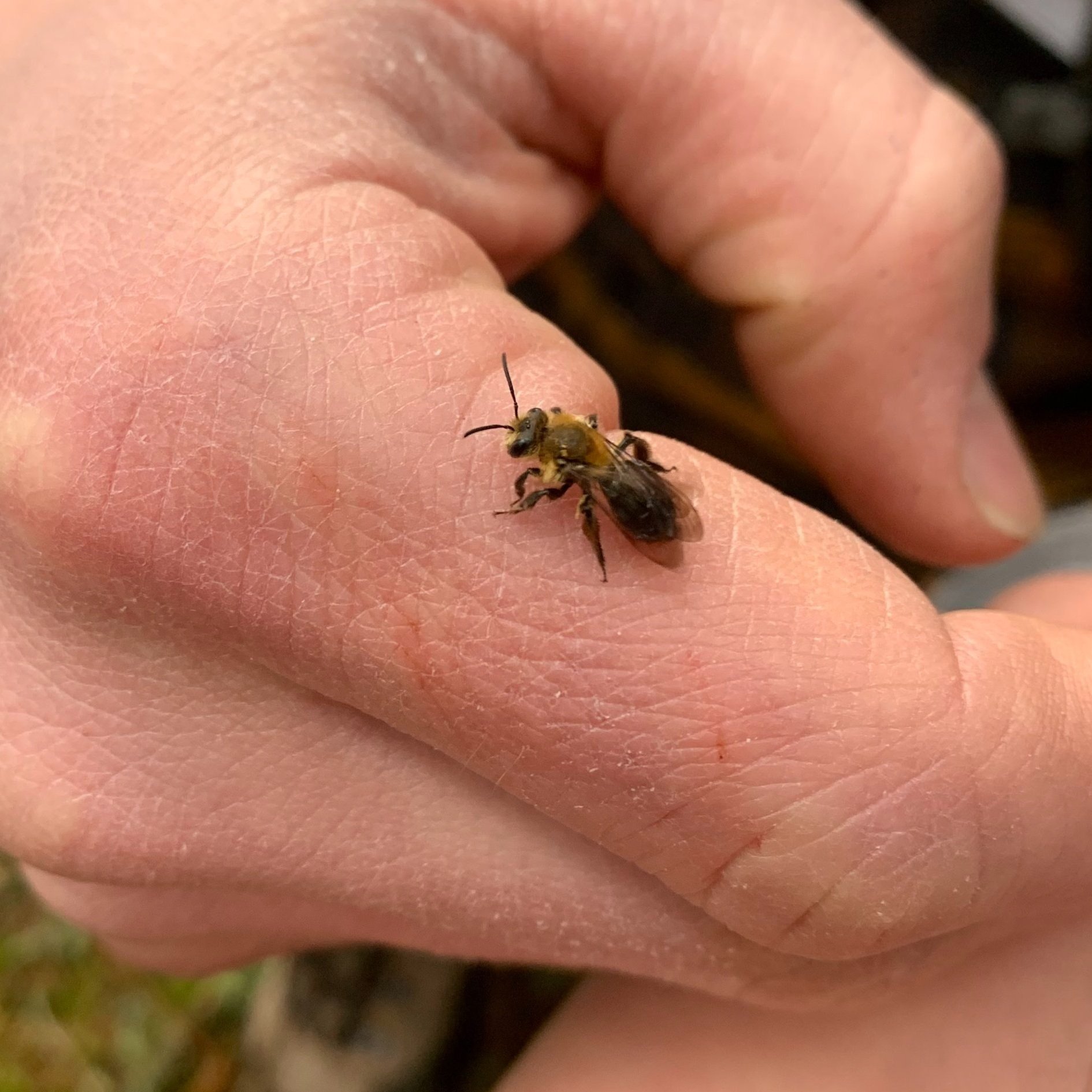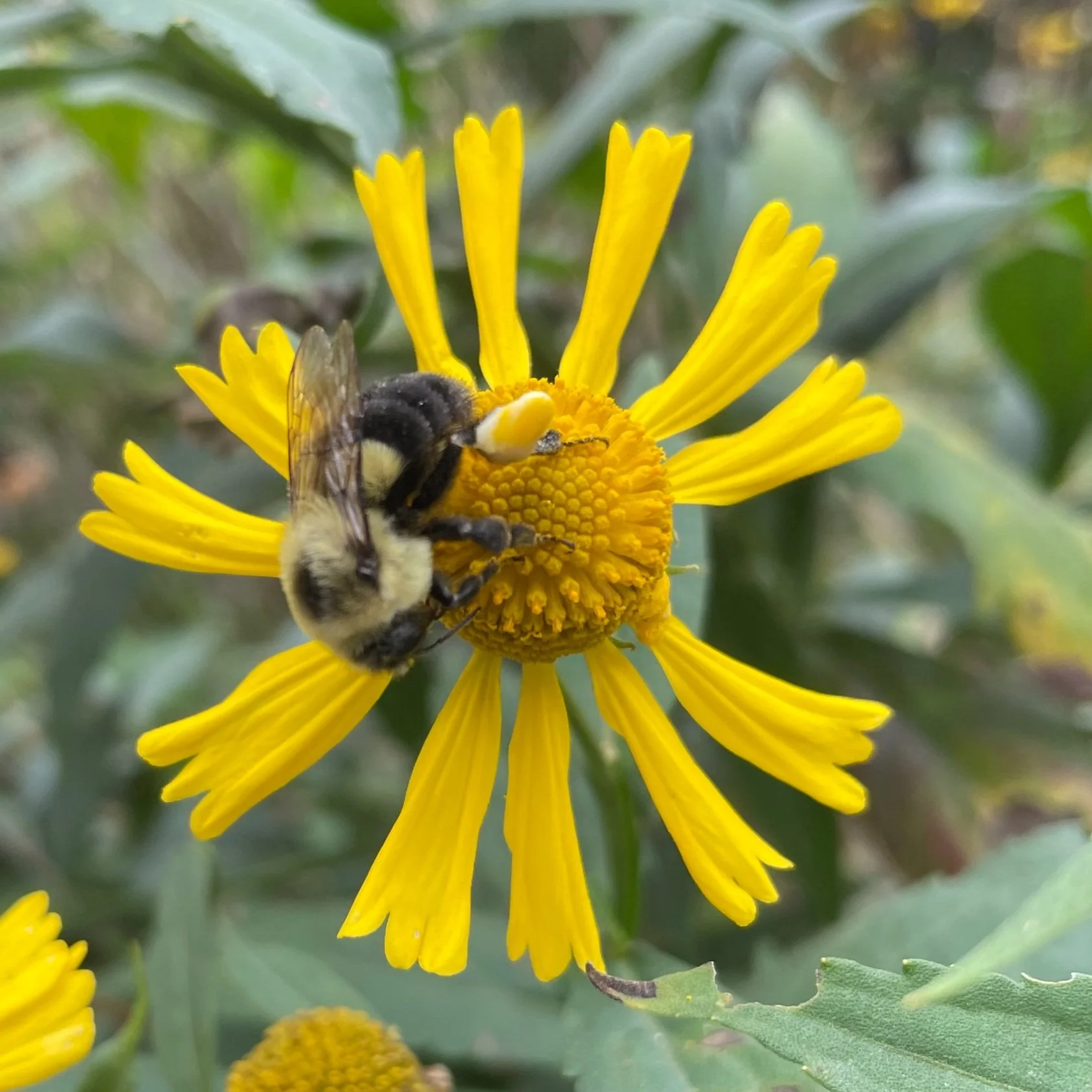Happy Bee-lated World Bee Day
We all love bees for the enormous role they play as pollinators. Over a third of the food we eat is thanks to these incredibly hard workers, as well as nearly all flowers and even many trees. When most people hear about bees, they usually imagine the European Honeybee, Apis mellifera. While this is an extremely important species to us humans, they are far from the only important species of bee out there. In fact, over 20,000 other species of bees have been described! Here in the US, more than 750 species can be found east of the Mississippi River. About a quarter of our native bees are specialists, meaning they have coevolved with a specific host plant to feed from and transfer pollen between its flowers. Without these native bees, a huge diversity of native wildflowers would disappear.
This Dunning’s Miner, Andrena dunningi, is taking a quick rest on a guide’s hand. As their name suggests, mining bees are ground-nesters. Females dig narrow burrows, preferably in clay soil. Although they are solitary nesters, several females will often construct nests near one another. These small bees overwinter as adults in their brood cells and emerge in early spring. While many mining bees are specialists, the Dunning’s miner is happy to visit several different families of spring blooms.
Despite being the poster child of Apoidea (the bee family), the European Honeybee is actually not very representative of the rest of the bees. While a few other species have social nests (the bumble bees and a handful of sweat bees), the majority of our native bees construct solitary nests or even just a few dispersed brood cells without a nest at all. Even in these social nests, there may be several fertile females that work together to raise their young rather than a single queen. Most bees nest underground, in plant stems, or in tree cavities and pack brood cells with enough rations to feed a larva to adulthood. The female will then lay a single egg in each and seal it off. These species are usually univoltine, meaning they have one generation every year. The larvae only eat the provisions their mothers stored for them before they pupate and emerge as adults the next year
The Spine-Shouldered Cellophane Bee, Colletes simulans, is a Goldenrod specialist. Like the rest of the Cellophane Bees, they nest underground in dry, sandy soil. This group of bees get their name from a plastic-like wax the females secrete that they use to line their nest, holding up the walls and making them waterproof.
There are many important pollinator species- butterflies and moths, flies, beetles, even some birds and bats. All of these species visit flowers to drink from its nectar and sometimes graze on pollen, then “accidentally” transport pollen between flowers. Bees are unique in their behavior of collecting and moving pollen on purpose. Female bees collect large quantities of protein-rich pollen and carbohydrate-rich nectar to provision her brood cells. As she visits flowers, she collects pollen in her pollen basket, commonly found either on the hind legs or under the abdomen. Upon visiting a new flower, she drops off some pollen she is already carrying to make room to pick up more. This results in very high rates of pollen exchange, helping the plant successfully fertilize its seeds.
This Two-spotted Bumblebee, Bombus bimaculatus, is collecting pollen from a sneezeweed aster. Perhaps the best known group of native bee, the bumblebees are adept pollinators. Most species are generalists and are active the entire growing season. Thanks to their long proboscis and robust build, they are able to access flowers with concealed nectaries. They are also some of the only native bees that live in eusocial nests made of a queen and her daughters.
In 2006, news broke of a crisis to bees- Colony Collapse Disorder. Data from beekeepers showed a decline of nearly a third of honeybee populations from 1989 to 2008. Several factors were identified including over-application of pesticides, the introduction of the Varroa mite to European honeybees, and the several disease outbreaks from hive transportation. Since 2008, honeybee populations have been recovering thanks to many of these threats being identified and mitigated. While this is a great success story for the domestic honeybees, research into our native bees’ populations is only just beginning. In addition to many of the same threats, native bees also suffer from habitat loss, resource scarcity, and competition with introduced species. In very recent years, lots of important research is being published, putting native bees in the spotlight of conservation efforts.
The Pugnacious Leafcutter Bee, Megachile pugnata, is an Aster family specialist. Female leafcutters use their large shear-like mandibles to cut circular flakes from leaves, which she uses to line her brood cells. Rather than a single nest with several brood cells, leafcutters typically build several dispersed brood cells in dead, hollow plant stems and other preexisting holes in plants.
If you have a garden, you can help support native bees just by being a lazy gardener. Instead of pulling weeds, do a quick search to see if that plant supports native species and only remove the invasive weeds. Try to support a variety of native wildflowers. Leave clippings on the edges of the garden to provide habitat and resources to nest-building bees. And avoid using toxic pesticides- by supporting a variety of species, they may begin to self-regulate. But an easy way we can all help out the native bees is just by learning a little about them, and checking in on them once in a while. So take a moment this spring and summer to appreciate some of nature’s hardest workers for all the beeauty they make possible.



